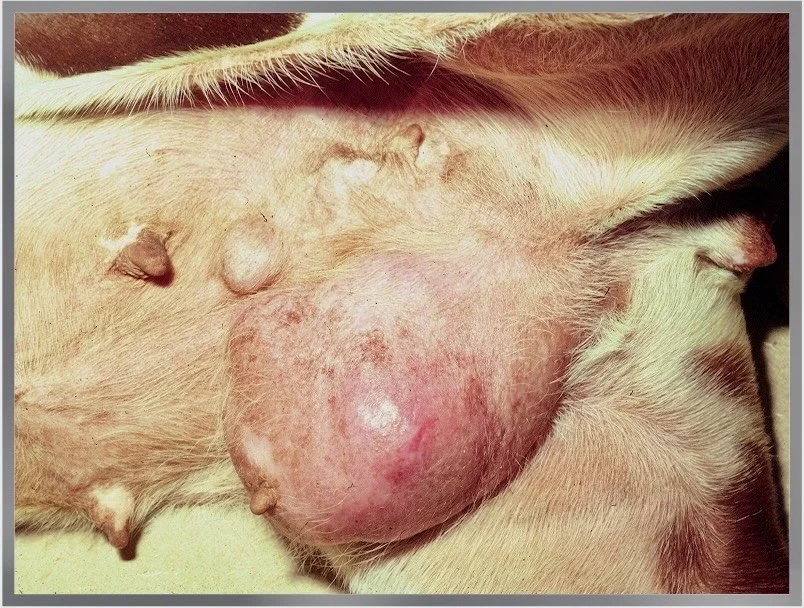
Mammary Tumors in Dogs and Cats
Mammary Tumors in Dogs and Cats
Mammary tumors are growths in the mammary glands (breasts). They are relatively common in unspayed female dogs and cats, but uncommon in male or spayed female dogs. Mammary tumors can be benign (non-cancerous) or malignant (cancerous) and the malignant form can spread to other parts of the body.
Who is at risk?
Dogs that are unspayed or were spayed after 2 years of age are at greatest risk.
Small dogs such as poodles and dachshunds are at higher risk
About 50% of mammary tumors in dogs are benign while 50% are malignant
About 85% of mammary tumors in cats are malignant and most exhibit aggressive biologic behavior.
Diagnosis
Mammary tumors are often diagnosed by palpating a mass in the region of the mammary gland or nipple. All mammary glands should be evaluated as multiple glands can be affected. Tumors are often small, firm, “BB” shaped masses, however mammary tumor take on many forms and may be a larger mass in the breast or appear as a swollen, painful breast with ulceration of the skin.
Figure 1: Large mammary mass in the groin region of a dog.
Your veterinarian may recommend procedures to stage the cancer (determine what type of cancer it is and if other parts of the body are affected):
Bloodwork
Chest radiographs
Abdominal Ultrasound
Fine needles aspirate of the mass or local lymph nodes
Possible biopsy of the mass
How are mammary tumors treated?
Surgery is most recommended to treat mammary tumors in cats and dogs. The type of surgery depends on the size, location and number of mammary tumors present. In general, surgery is more conservative for dogs and involves removal of the mass itself or removal of the affected mammary gland. In cats however, more extensive surgery is required (mammary chain removal), and removal of both mammary chains (left side and right side) is often recommended in two surgical procedures, separated by about 2-3 weeks. Inflammatory carcinoma is a type of mammary tumor where surgery is not indicated.
In most cases, it is recommended to spay your dog or cat at the time of mammary tumor removal if your pet is still unspayed. In cats, spaying will reduce the risk of future mammary tumors. It is unclear in dogs if spaying affects the prognosis of the mammary tumor, however it does prevent other unrelated diseases such as pyometra (a potentially life threatening infection in the uterus that is more common as your dog ages).
The removed mass will be sent to a pathologist for evaluation after surgery. The pathologist will tell us what type of tumor was present and if it was benign or malignant.
What is recovery like?
After surgery your pet will need to have restricted activity for 10-14 days while the incision heals. No running, jumping or playing should be allowed and they should stay on a leash when taken outside to use the bathroom. Your pet will also be sent home with pain medications to help keep them comfortable. An E-collar (a protective device) is often necessary to prevent any licking or chewing of the incision.
Immediately post-surgery, your pet may be drowsy, uncoordinated or nauseous. Unless otherwise instructed, we normally recommend the following for food and water:
Water Reintroduction: Offer a small amount of water 30 minutes to 1 hour after arriving. If there are no signs of nausea and water is kept down, more can be offered in small amounts. You may resume normal water access the following day,
Food Reintroduction: Offer 1/2 their normal feed 2 hours after arriving home. If there are no signs of nausea and food is kept down, you may resume normal feedings the following day.
Detailed postoperative instructions will be provided to you after the surgery that outline medications, and incision care. Bandages on the IV catheter site can be removed once you get home. Local bandages applied to the surgical site can be removed in 72 hours unless otherwise instructed. It is normal for some bruising and swelling to occur. If there is no pain or discharge associated with the swelling, continue to monitor at home. Please notify us or your veterinarian if you observe:
Increased redness/bruising over time
Odorous or pus-like discharge
Opening of the incision site
Increased swelling
Vomiting
Signs of acute pain.
Depending on the results of the biopsy, consultation with an oncologist may be recommended to discuss further treatment such as chemotherapy and monitoring.
Prognosis
Several factors influence the prognosis following surgery including the size of the tumor (smaller tumors have a more favorable prognosis), the tumor type and grade, and extent of the cancer (is there evidence it has spread into the lymph nodes or other organs).
Benign tumors can be cured with surgery alone. Mammary tumors behave more aggressively in cats, and the prognosis is guarded. Mammary tumors may occur in remaining glands, so it is important to monitor for the development of new tumors.
What can I do to reduce my pet’s risk of mammary tumor development?
Spaying cats and dogs before their first heat cycle will largely prevent the development of mammary tumors. Please discuss this and other factors to consider when deciding to spay you dogs or cat with your general veterinarian.

